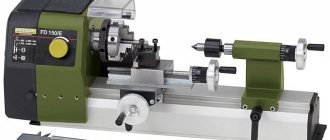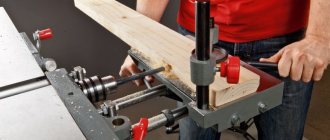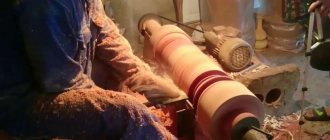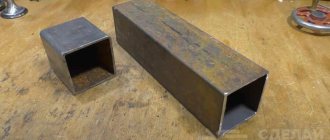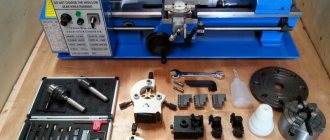20.03.2020
- Purpose and description
- Varieties
- How does a lathe work and what does it consist of?
- Diagram of a lathe with all the main devices
- What does a lathe do and how does it work?
- Operating a lathe: how to turn on the device and start working
- How to install and configure a lathe
- How to choose a metal lathe and make out the markings
Turning is one of the most popular and in demand metalworking methods. In this article we will tell you about the design of a universal metal lathe, what kind of equipment it is, what technical characteristics it has, how to choose and install a suitable one and carry out processing on it, as well as about its types.
Classification of lathes
According to the classification of metal-cutting equipment, turning equipment is divided into:
- Single-spindle and semi-automatic machines
- Multi-spindle and semi-automatic machines
- Revolving
- Drilling and cutting
- Lobototurny
- Multi-cutting (screw-cutting)
- Specialized
- Various lathes
- Carousel
Specialized automatic and semi-automatic machines are used for the manufacture of parts that require unique processing; the operation of the machine is partially or fully automated. Semi-automatic machines cannot independently load and unload parts with workpieces; this operation is performed by the operator.
Single-spindle and semi-automatic machines are used for complex processing in large-scale production.
- Multi-spindle and semi-automatic machines. Several workpieces are fixed on the spindle block, after which they are moved one by one to the working position, and they are processed using several tool groups.
- Turret machines are fundamentally special in that they have a rotating head in which everything necessary is fixed, thereby saving processing time.
- Drilling and cutting equipment is designed for synchronous cutting and drilling of volumetric workpieces.
Lathe turning equipment is designed for turning short workpieces of large diameters. It is possible to process workpieces of uneven diameters thanks to independent cams on the faceplate. Quite rarely found in production due to a number of disadvantages, such as low accuracy and productivity.
Screw-cutting lathes are the most recognizable equipment of the turning group. It can be used for turning, drilling, and end processing. Additional functions include thread cutting and cone turning.
Specialized machines are necessary for the manufacture of parts of a narrow range.
Rotary machines are simply irreplaceable when processing large workpieces of short length. Due to their high precision, rotary lathes have almost completely replaced lobot lathes. The horizontal position of the faceplate determines the operating features of the equipment.
Lathe device
Lathes consist of the following structural elements:
- Bed – the main part of the machine on which all components and mechanisms are located;
- An apron that converts the movement of the drive shaft or screw into the longitudinal movement of the caliper;
- A support where the cutting tool is secured;
- Feed box, which communicates movement from the drive shaft or screw to the caliper;
- An electric motor that provides the machine with electricity;
- The spindle head, which houses the spindle of the machine.
Operating a lathe: how to turn on the device and start working
First you need to install the workpiece in two spindles and check the reliability of the fastening. If one of the holders flies out of its place at high speed, serious consequences are possible, both for the equipment and for the engineer. The second stage is the selection and installation of the tool. For classic tasks, cutters are used; sometimes drills or taps may be needed (when drilling holes and applying internal threads). In CNC-equipped equipment, both of these operations are often performed automatically. On semi-automatic machines this is done by the operator.
Further actions may vary depending on the type of machine.
On automatic:
- ● Develop a project, enter data into the control system.
- ● Turn on the lathe.
- ● Monitor the correct execution of the procedure.
For manual production:
- ● Turn on the engine.
- ● Using the gearbox, select the optimal number of rotations per second.
- ● Use the handles and wheel to control the movement of the caliper, cutting off the desired size of the top layer.
Also, control measurements should be carried out at different stages. Then you can sand it.
What causes injuries?
Factors that pose a threat to humans include:
- Spindle rotation
- Chips flying during processing
- Coolant splashes
- Machine voltage
- Sharp burrs on workpieces
Each worker is given instructions that describe all the points regarding the rules of behavior when operating the equipment. Operators are required to comply with all requirements.
General provisions
Persons who have completed all introductory instructions, fire safety instructions, and safety instructions are allowed to work on a lathe.
- Working on a lathe is impossible without special clothing. Headgear and safety glasses are required.
- Women are required to hide their hair under a headdress, however, this also applies to men.
- Hair should be styled in such a way as to exclude any possibility of it coming into contact with the rotating mechanisms of the machine.
Important! It is forbidden to use gloves while working, as threads protruding from them can get caught in the rotating chuck, which will lead to injury to the operator. The worker is also required to fasten all buttons on his sleeves for the same reasons.
The machine must be grounded and fixed. If it is being repaired, there should be a corresponding sign on it.
Activities not related to work are prohibited in the workplace: smoking, eating, using a mobile phone.
Workers under the influence of alcohol or drugs are not allowed to work on a lathe. Workers who are taking medications that slow their reactions are also not allowed.
Machines equipped with CNC system
Enterprises specializing in small-scale production of metal products have always strived to automate machining processes. The efforts of engineers and designers led to the development and improvement of equipment equipped with a CNC system. Such machines differ from conventional ones in their layout; for example, CNC units have inclined guides. This structural element facilitates chip flow, thus protecting the cutting zone.
You can program a CNC lathe to automatically perform the following actions:
- spindle speeds switched;
- the caliper moved;
- the revolver head turned;
- the main movement drive started and stopped;
- the tool was automatically changed (of course, if a multi-tool magazine is provided).
Tool setting is not done on the machine. This procedure is carried out using optical devices or special devices using indicators and templates. Already adjusted blocks or an entire tool holder are installed on metal-cutting equipment.
Units equipped with a CNC system differ from each other in the specificity of their auxiliary movements. In this regard, the following groups of machines are distinguished:
- with one camshaft rotating at a constant frequency;
- with one camshaft capable of rotating at one frequency out of two possible;
- with camshaft and high-speed shaft.
During work
Safety precautions when operating the equipment:
- Securely secure workpieces;
- Remove chips in a timely manner using a special hook and prevent them from wrapping around the part;
- Monitor the proper operation of the machine; in case of deviation, stop work immediately;
- Support long parts either with movable supports (rests) or with a tailstock
Important! It seems stupid, but before work you MUST remove the key from the socket.
Prohibited:
- Touch the part with your hands or foreign objects;
- Work with gloves
- Try to fix equipment failure yourself;
- Cool parts with a damp cloth;
- Getting distracted while working;
- Transmit anything through operating equipment;
- Leave the machine running unattended.
After work
Upon completion of equipment operation, you must:
- Turn off the power;
- Clean the machine and the space around it from chips and liquids;
- Place tools, workpieces and parts;
- In the event of a breakdown, report it to management;
- Wash your hands and face thoroughly, take off your overalls.
Safety precautions
Before you start using the lathe, you need to properly prepare for work:
- Wear safety glasses and protective clothing with no protruding parts.
- Completely clear the workplace of foreign objects, free up space around the machine so that you can move freely.
- Check the machine for damage to main parts, fasteners, and wire connections.
The work area should be well lit. If possible, you need to place a large number of lamps around the equipment.
Safety regulations:
- Cleaning the work area, removing workpieces, and lubricating working mechanisms is only possible with the engine turned off.
- When cutting metal parts, do not hold the part to be cut by hand.
- It is not recommended to pass objects over a running mechanism.
- When processing parts, you need to be on the correct side of the machine, at a safe distance from it.
- It is prohibited to lean on the working parts of the machine.
After completing the work, you need to clean the workplace and remove metal shavings.
Tips for choosing
When choosing a lathe, it is necessary to take into account the material being processed, its dimensions, the dimensions of the machine and, of course, the budget. A small-sized screw-cutting lathe with low power is suitable for a garage.
For production, it is recommended to take a closer look at more powerful and versatile equipment.
It is also recommended that when purchasing a machine, you carefully inspect it for cracks, breakages, abrasions, and so on.
Industrial equipment
From among the standard fuel assemblies of the industrial group, you can select an option for both the workshop and the experimental workshop. The discreteness of the stroke and the permissible error are regulated by standards. The operation of components and mechanisms is ideal with the established maintenance procedure. The difficulty of choice lies in a thorough comparison of the capabilities of a standard machine and the expected operating features. Minor modifications are allowed. If there are obvious non-conformities, upgrading must be carried out by the manufacturer. Optimally – fuel assemblies made to order.
Stalex GH-1430B – from RUB 540,611.
The oil bath of the gearbox, from which the headstock bearings are lubricated, and the rigidity of the structure bring the domestically developed product as close as possible to the high standard of older FA models.
The advantage of the younger machine is the error declared by the manufacturer of 0.005 mm. Considering the features of service and the stated cost, I can confidently say that equipment with such precision should be classified as industrial. Which, despite its average dimensions, will be effectively used only in the conditions of a production and experimental workshop. Characteristics of Stalex GH-1430B
| Characteristic | Meaning |
| Permissible diameter of the workpiece above the bed, mm | 330 |
| Distance between centers, mm | 750 |
| Spindle through hole diameter, mm | 38 |
| Speed, rpm | 70 — 2000 |
| Weight, kg | 510 |
| Features of the basic configuration |
|
| Homeland of the brand | Russia |
Proma SPF-2000PH – from RUB 1,220,000.
For drilling, reaming holes, grinding parts and rolling corrugations on the scale of repair and locksmith shops of large enterprises, accurate and powerful machines are required. The Czech version with a 2-meter working surface of the bed, a 5.5 kilowatt electric motor and a hydraulic station for supplying lubricating and cooling fluid meets all the requirements for industrial equipment. 2 steady rests on the bed increase the efficiency of processing large-sized workpieces. Maintenance of Proma SPF-2000PH requires certain qualifications from personnel. Therefore, at enterprises, the replacement of process fluids and local repairs are entrusted to highly specialized specialists. I recommend entrusting the first commissioning work to specialists from the manufacturer. Characteristics of Proma SPF-2000PH
| Characteristic | Meaning |
| Permissible diameter of the workpiece above the bed, mm | 460 |
| Distance between centers, mm | 2000 |
| Spindle through hole diameter, mm | 80 |
| Speed, rpm | 25 - 1800 (12 speeds) |
| Weight, kg | 3055 |
| Features of the basic configuration |
|
| Development/production | Czech |
Jet GH-2040 ZH DRO RFS – from RUB 1,165,000.
The index “2040” in the TVS marking identifies the junior model of the senior line of standard lathes of the GH ZH DRO RFS series, from the international corporation JET.
The differences between each of the 4 options are in the dimensions of the equipment and the maximum length of the workpiece. The motor is 12 kW, the parameters of each of the 4 possible thread options, the rotation speed of the feed shaft for the GH ZH DRO RFS models are completely identical. Which allows us to conclude about the impressive potential of fuel assemblies with code 2040. Characteristics of JET GH-2040 ZH DRO RFS
| Characteristic | Meaning |
| Permissible diameter of the workpiece above the bed, mm | 500 |
| Distance between centers, mm | 1015 |
| Spindle through hole diameter, mm | 80 |
| Speed, rpm | 9 – 1600 (24 positions) |
| Weight, kg | 2750 |
| Features of the basic configuration |
|
| Development/production | Switzerland/SEA, Europe |
A detailed review of the model - issues from configuration to the hardness of the frame are considered; Maximum cut per revolution tested:
Rating of the best machines
| Place | Model | Advantages | Flaws |
| 1 | JET GHB-1330A DRO | Versatility Reliability Easy to set up Digital display system | High price |
| 2 | STALEX C0632D/1000 | Multifunctionality High accuracy Comfortable | High price |
| 3 | METALMASTER MML 2870M (15461) | Operates from 220V Multifunctionality Smooth adjustment of the router | There is no lubricating fluid supply system |
| 4 | JET BD-12G 220B 50000913M | High quality performance Safety Automatic feeding Reliability | High cost Small set of available functions |
| 5 | JET BD-X7 50000900MX | Compact and lightweight Availability of longitudinal feed automation Good accuracy | No lubricant supply system Manual cross feed |
| 6 | STALEX D250X400C | High quality performance Availability of a protective screen High accuracy | Heavy for its size Manual cross feed |
| 7 | CALIBER STMN-550/350 | Cheap Small dimensions Almost silent | Poor build quality |
Small Business Equipment
The selection of fuel assemblies for a production or repair business project is always carried out taking into account the inevitable modernization for similar tasks. There are no problems with processing precision for equipment in this category. Wear resistance is also at the level. But some manufacturers rely on the universal potential, others on the dimensions of the machine’s working area. Identify your main tasks and look for a machine to implement them. Then the purchase of a new fuel assembly will not affect the profitability of the business.
Proma SKF-800 – from RUB 272,365.
The combination of milling and screw-cutting devices within one lathe turned out to be one of the best solutions of the Czech Proma SKF-800.
The rotary drilling unit and the impressive diameter of the hole in the spindle allow you to work with fairly large parts. 2 identical three-phase motors guarantee sufficient torque for each device. A worthy option for those who plan to engage in professional activities in a small workshop. The only design flaw is the lack of tight contact of the protective panels with the frame. Because of this, chips and lubricants can cause rapid wear of the drive mechanisms. The manufacturer recommends that exposed parts be thoroughly cleaned and lubricated twice a day. I recommend checking the belt tension during each maintenance break. Characteristics of Proma SKF-800
| Characteristic | Meaning |
| Permissible diameter of the workpiece above the bed, mm | 420 |
| Distance between centers, mm | 750 |
| Spindle through hole diameter, mm | 28 |
| Speed, rpm | 160 -1360 (7 steps) |
| Weight, kg | 230 |
| Features of the basic configuration |
|
| Homeland of the brand and country of origin | Czech |
Video from the manufacturer Proma, the video shows the performance characteristics and reveals the functionality of the machine:
MetalMaster X32100 – from RUB 284,970.
Thread indicator, digital display device, longitudinal and transverse automatic feed system; supply of lubricant and cooling fluid - a machine from MetalMaster simplifies the process of metal processing without loss of quality. Professionals often compare the functionality of this machine with Soviet equipment of a similar profile. I consider such analogies to be incorrect - apart from a certain set of functions, nothing connects them.
- X32100 removes 3 mm chips in one pass
- Discretion of carriage stroke in any direction – 0.001 mm
- MetalMaster provides the opportunity to reduce equipment costs by 12% by eliminating the digital display device (12% of the cost).
With such a ratio of potential, compact dimensions, ergonomic controls and 1 year of official warranty, this machine has no competitors in the price segment up to 300,000.
Characteristics of MetalMaster X32100
| Characteristic | Meaning |
| Permissible diameter of the workpiece above the bed, mm | 330 |
| Distance between centers, mm | 1000 |
| Spindle through hole diameter, mm | 38 |
| Speed, rpm | 65 - 1810 (18 speeds) |
| Weight, kg | 520 |
| Features of the basic configuration |
|
| Development/production | Russia/countries of Southeast Asia (SEA) |
The video shows the machine in operation - the thread cutting process on this unit is demonstrated. In principle, everything is done easily, and special training is not needed at all to work on this machine:
Jet GHB-1330A – from RUB 350,000.
The scope of use of this fuel assembly is small-scale production and piece products.
Weight, length of the frame and a small basic set of accessories indicate the professional orientation of the equipment. That is, when the necessary equipment is purchased as needed to perform specific tasks. Having experience working on this machine, I can say that in addition to convenient control and actual power, the length of the bed or the width of the through hole of the spindle is definitely not enough. Changes had to be made to the order for meter-long spatial structure elements made from a 50-millimeter pipe at the discussion stage. If the specifics of the work are not related to the maintenance of construction sites, then this machine will be a justified investment in the development of your business. Characteristics of JET GHB-1330A
| Characteristic | Meaning |
| Permissible diameter of the workpiece above the bed, mm | 330 |
| Distance between centers, mm | 760 |
| spindle through hole diameter, mm | 38 |
| Speed, rpm | 70 - 2000 (8 speeds) |
| Weight, kg | 600 |
| Features of the basic configuration |
|
| Development/production | Switzerland/SEA, Europe |
Detailed video review of the model. The author provides the performance characteristics of the machine, its functionality, and demonstrates it in operation:




